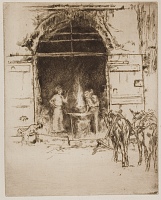Etchings Institutions search term: hughes kimber
Flaming Forge | ||
| Number: | 490 | |
| Date: | 1901 | |
| Medium: | etching | |
| Size: | 192 x 154 mm | |
| Signed: | butterfly at left | |
| Inscribed: | no | |
| Set/Publication: | no | |
| No. of States: | 1 | |
| Known impressions: | 16 | |
| Catalogues: | K.-; M.-; T.-; W.- | |
| Impressions taken from this plate (16) | ||
KEYWORD
building, dog, donkey, doorway, forge, man standing, smith.
TITLE
Although no dated record of Whistler's title was kept, the known title is appropriate:
'Flaming Forge' (1903/1935, possibly Rosalind Birnie Philip (1873-1958)). 2
Miss Birnie Philip, who gave the copper plate to the University of Glasgow in 1935, may have recorded the title when the artist returned from Corsica in 1901, and she helped to reorganise his studio. Alternatively, it may have been recorded after his death in 1903, or when arranging the transfer to Glasgow.
'Flaming Forge' (1903/1935, possibly Rosalind Birnie Philip (1873-1958)). 2
Miss Birnie Philip, who gave the copper plate to the University of Glasgow in 1935, may have recorded the title when the artist returned from Corsica in 1901, and she helped to reorganise his studio. Alternatively, it may have been recorded after his death in 1903, or when arranging the transfer to Glasgow.
2: Envelope containing copper plate, Hunterian Art Gallery.
DESCRIPTION
A tall arched entrance (with metal cross-beams supporting the arch) is flanked by two sturdy wooden doors. The flames of the forge are seen leaping high within a dark interior. In front, there are two smiths; the one on the left wears a long leather apron; the smith on the right is striking metal on the anvil with a hammer, the anvil being in the centre of the entrance, in full daylight.
To the left of the entrance, a skinny mongrel is peering into the smithy. To the right, in the foreground, are two donkeys or mules, seen from behind, with wooden cradles for panniers on their backs. In front of the entrance, and to left of the mules, is a wooden cradle lying on the ground. At the far right is a yard with stacks of wood, with houses glimpsed in the distance.
SITE
The forge was in Ajaccio, the capital of Corsica: the etching was probably based on his two pencil sketches by Whistler (r.: The Forge; v.: Smiths, Ajaccio
[m1679] and The Flaming Forge, Ajaccio
[m1678]), one of which is reproduced above. It could have been drawn on the plate in Ajaccio but perhaps etched and printed back in London.
DISCUSSION
The subject and composition are comparable to earlier etchings such as The Forge
[86], The Little Forge, Liverpool
[141], Nocturne: Furnace
[208] and The Smithy
[239]. Of these, Nocturne: Furnace is closest, being a view from outside looking into a room lit by the furnace. However, despite a similar interest in complex effects of light and shade, the technique is adapted to the specific lighting conditions in each case. MacInnes pointed out:
'Where the Venetian etching had blurred images of windows and reflections in twilight the other has crisply concise linear details of donkeys, wooden doors and the street behind in bright daylight; where in the former the tiny figure in front of the furnace is indicated by a very few dots and lines, the Ajaccio smiths emerge with their anvil and forge shimmering in the light entering the doorway.' 3
3: MacInnes 1969 , p. 337.

